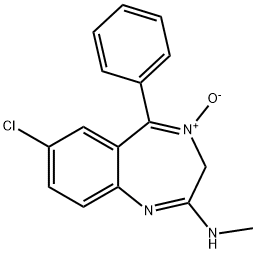Chlordiazepoxide
- CAS No.
- 58-25-3
- Chemical Name:
- Chlordiazepoxide
- Synonyms
- ocm;Librax;Solium;Risolid;LIBRIUM;Control;CHLORDIAZEPOXIDE BASE;7-Cloro-2-metilamino-5-fenil-3H-1,4-benzodiazepina 4-ossido;3H-1,4-Benzodiazepin-2-amine, 7-chloro-N-methyl-5-phenyl-, 4-oxide;Eden
- CBNumber:
- CB2409270
- Molecular Formula:
- C16H14ClN3O
- Molecular Weight:
- 299.75
- MDL Number:
- MFCD00481188
- MOL File:
- 58-25-3.mol
| Melting point | 230-232°C |
|---|---|
| Boiling point | 549.0±60.0 °C(Predicted) |
| Density | 1.2967 (rough estimate) |
| refractive index | 1.6490 (estimate) |
| Flash point | 9℃ |
| storage temp. | Controlled Substance, -20°C Freezer, Under Inert Atmosphere |
| solubility | Practically insoluble in water, sparingly soluble in ethanol (96 per cent) |
| pka | 4.8(at 25℃) |
| form | A crystalline solid |
| Water Solubility | 2g/L(room temperature) |
| CAS DataBase Reference | 58-25-3(CAS DataBase Reference) |
| EWG's Food Scores | 1 |
| FDA UNII | 6RZ6XEZ3CR |
| NIST Chemistry Reference | Benzodiazepine-4-oxide, 7-chloro-2-methylamino-5-phenyl-3h-1,4-(58-25-3) |
| Proposition 65 List | Chlordiazepoxide |
| ATC code | N05BA02 |
| EPA Substance Registry System | Chlordiazepoxide (58-25-3) |
SAFETY
Risk and Safety Statements
| Symbol(GHS) |    GHS02,GHS06,GHS08 |
|||||||||
|---|---|---|---|---|---|---|---|---|---|---|
| Signal word | Danger | |||||||||
| Hazard statements | H225-H301+H311+H331-H370 | |||||||||
| Precautionary statements | P210-P260-P280-P301+P310-P311 | |||||||||
| Hazard Codes | F,T | |||||||||
| Risk Statements | 11-23/24/25-39/23/24/25 | |||||||||
| Safety Statements | 7-16-36/37-45 | |||||||||
| RIDADR | 3249 | |||||||||
| WGK Germany | 1 | |||||||||
| HazardClass | 6.1(b) | |||||||||
| PackingGroup | III | |||||||||
| HS Code | 2933910000 | |||||||||
| Toxicity | LD50 oral in rabbit: 590mg/kg | |||||||||
| NFPA 704 |
|
Chlordiazepoxide Chemical Properties,Uses,Production
Chemical Properties
Pale Yellow Solid
Originator
Librium,Roche,W. Germany,1960
Uses
Controlled substance (depressant). Anxiolytic. Prototype of the benzodiazepine anxiolytics
Definition
ChEBI: A benzodiazepine that is 3H-1,4-benzodiazepine 4-oxide substituted by a chloro group at position 7, a phenyl group at position 5 and a methylamino group at position 2.
Manufacturing Process
A mixture of 202 g 2-amino-5-chlorobenzophenone, 190 g hydroxylamine
hydrochloride, 500 cc pyridine and 1,200 cc alcohol was refluxed for 16 hours,
then concentrated in vacuo to dryness. The residue was treated with a
mixture of ether and water. The water was separated, the ether layer
containing a considerable amount of precipitated reaction product was washed
with some water and diluted with petroleum ether. The crystalline reaction
product, 2-amino-5-chlorobenzophenone-alpha-oxime, was filtered off. The
product was recrystallized from a mixture of ether and petroleum ether
forming colorless prisms, MP 164 to 167°C.
To a warm solution (50°C) of 172.5 g (0.7 mol) of 2-amino-5-
chlorobenzophenone-alpha-oxime in one liter glacial acetic acid were added
110 cc (1.47 mols) chloroacetyl chloride. The mixture was heated for 10
minutes at 50°C and then stirred at room temperature for 15 hours. The
precipitated yellow prisms, 2-chloromethyl-4-phenyl-6-chloroquinazoline 3-
oxide hydrochloride, were filtered off, melting range 128° to 150°C with dec.
The acetic acid mother liquor, containing the rest of the reaction product, was
concentrated in vacuo. The residue was dissolved in methylene chloride and
washed with ice cold sodium carbonate solution. The organic solution was
dried, concentrated in vacuo to a small volume and diluted with ether and
petroleum ether. Fine yellow needles of 2-chloromethyl-4-phenyl-6-
chloroquinazoline 3-oxide precipitated. The pure base was recrystallized from
a mixture of methylene chloride, ether and petroleum ether, MP 133° to
134°C.
Ninety-eight grams of 6-chloro-2-chloromethyl-4-phenylquinazoline 3-oxide
hydrochloride were introduced into 600 cc of ice cold 25% methanolic
methylamine. The mixture was initially cooled to about 30°C and then stirred
at room temperature. After 15 hours the reaction product which precipitated
was filtered off. The mother liquor was concentrated in vacuo to dryness. The
residue was dissolved in methylene chloride, washed with water and dried
with sodium sulfate. The methylene chloride solution was concentrated in
vacuo and the crystalline residue was boiled with a small amount of acetone
to dissolve the more soluble impurities. The mixture was then cooled at 5°C
for 10 hours and filtered. The crystalline product, 7-chloro-2-methylamino-5-
phenyl-3H-1,4-benzodiazepine 4-oxide, was recrystallized from ethanol
forming light yellow plates, MP 236° to 236.5°C.
A solution of 7-chloro-2-methylamino-5-phenyl-3H-1,4-benzodiazepine 4-oxide
in an equivalent amount of methanolic hydrochloric acid was diluted with
ether and petroleum ether.
The precipitated hydrochloride was filtered off and recrystallized from
methanol, MP 213°C.
brand name
Librium (Valeant).
Therapeutic Function
Tranquilizer
Synthesis Reference(s)
The Journal of Organic Chemistry, 26, p. 1111, 1961 DOI: 10.1021/jo01063a034
Hazard
Anticonvulsant, sedative, and amnesic properties.
Metabolism
Chlordiazepoxide is well absorbed after oral administration, and peak blood concentration usually is reached in approximately 4 hours. Intramuscular absorption of chlordiazepoxide, however, is slower and erratic. The half-life of chlordiazepoxide is variable but usually quite long (6–30 hours). The initial N-demethylation product, N-desmethylchloridiazepoxide, undergoes deamination to form the demoxepam, which is extensively metabolized, and less than 1% of a dose of chlordiazepoxide is excreted as demoxepam. Demoxepam can undergo four different metabolic fates. Removal of the N-oxide moiety yields the active metabolite, N-desmethyldiazepam (desoxydemoxepam). This product is a metabolite of both chlordiazepoxide and diazepam and can be hydroxylated to yield oxazepam, another active metabolite that is rapidly glucuronidated and excreted in the urine. Another possibility for metabolism of demoxepam is hydrolysis to the “opened lactam,” which is inactive. The two other metabolites of demoxepam are the products of ring A hydroxylation (9-hydroxydemoxepam) or ring C hydroxylation (4′-hydroxydemoxepam), both of which are inactive.
Chlordiazepoxide Preparation Products And Raw materials
Raw materials
1of2





